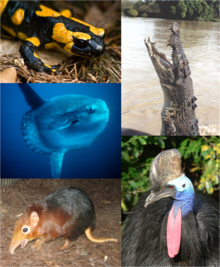Vertebrates
| Vertebrates Temporal range: Cambrian - Present,525–0 Ma |
|
|---|---|
 |
|
| Individual organisms from each major vertebrate group. Clockwise, starting from top left:
Fire salamander (Amphibia), saltwater crocodile (Reptilia), southern cassowary (Aves), black-and-rufous giant elephant shrew (Mammalia), ocean sunfish (Osteichthyes) |
|
| Scientific classification | |
| Kingdom: | Animalia |
| Phylum: | Chordata |
| Clade: | Craniata |
| Subphylum: |
Vertebrata J-B. Lamarck, 1801 |
| Simplified grouping (see text) | |
| Synonyms | |
|
Ossea Batsch, 1788 |
|
Fire salamander (Amphibia), saltwater crocodile (Reptilia), southern cassowary (Aves), black-and-rufous giant elephant shrew (Mammalia), ocean sunfish (Osteichthyes)
Ossea Batsch, 1788
Vertebrates /ˈvɜːrtᵻbrᵻts/ comprise all species of animals within the subphylum Vertebrata /-ɑː/ (chordates with backbones). Vertebrates represent the overwhelming majority of the phylum Chordata, with currently about 64,000 species described. Vertebrates include the jawless fish and the jawed vertebrates, which include the cartilaginous fish (sharks and rays) and the bony fish.
A bony fish clade known as the lobe-finned fishes is included with tetrapods, which are further divided into amphibians, reptiles, mammals, and birds. Extant vertebrates range in size from the frog species Paedophryne amauensis, at as little as 7.7 mm (0.30 in), to the blue whale, at up to 33 m (108 ft). Vertebrates make up less than five percent of all described animal species; the rest are invertebrates, which lack vertebral columns.
...
Wikipedia
